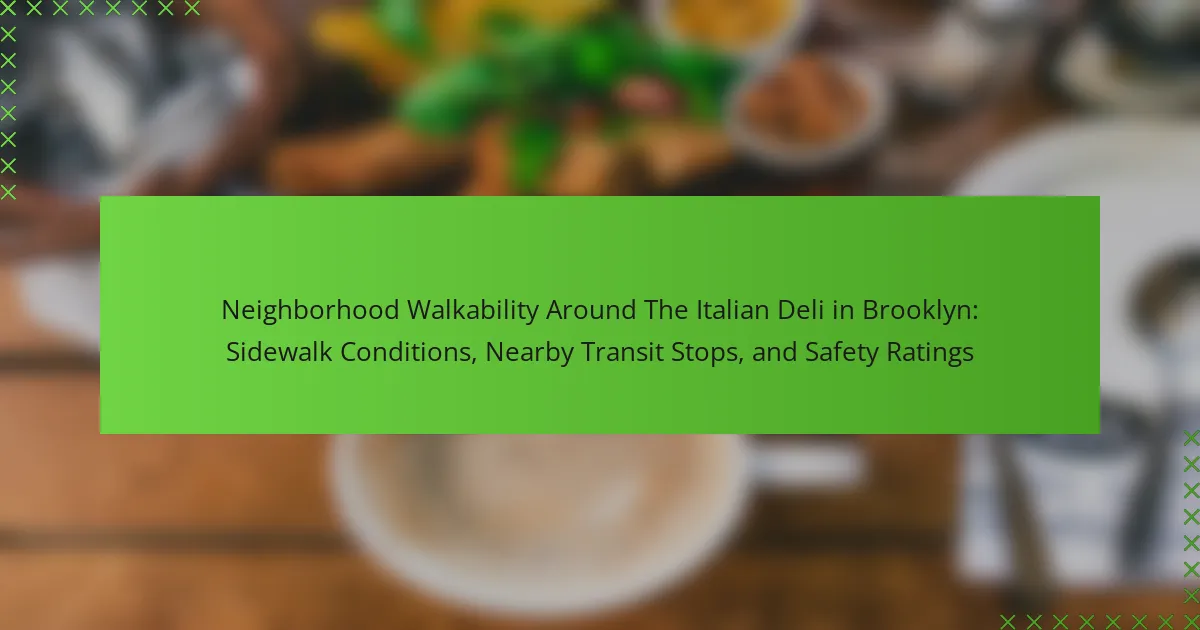
What is Neighborhood Walkability Around The Italian Deli in Brooklyn?
Neighborhood walkability around the Italian Deli in Brooklyn is rated as high. The area features well-maintained sidewalks suitable for pedestrians. Nearby transit stops enhance accessibility, making it easy to reach various destinations. Safety ratings in the neighborhood indicate a generally secure environment for walking. Local amenities, such as parks and shops, are within walking distance, promoting a pedestrian-friendly atmosphere. The presence of crosswalks and traffic signals further supports safe navigation for walkers. Overall, the combination of these factors contributes to the high walkability score in this Brooklyn neighborhood.
How is walkability defined in urban environments?
Walkability in urban environments is defined as the measure of how friendly an area is to walking. It encompasses factors such as the presence of sidewalks, pedestrian crossings, and overall safety. Walkability is influenced by the density of destinations within walking distance. Areas with mixed-use developments promote higher walkability scores. Research indicates that walkable neighborhoods contribute to increased physical activity. Studies show that higher walkability correlates with reduced vehicle reliance. In urban planning, walkability is pivotal for sustainable development. It enhances community interaction and accessibility to public transit.
What factors contribute to walkability in neighborhoods?
Walkability in neighborhoods is influenced by several key factors. Sidewalk conditions play a crucial role; well-maintained sidewalks encourage pedestrian use. Proximity to transit stops enhances accessibility, making it easier for residents to walk to public transport. Safety ratings also impact walkability; neighborhoods with lower crime rates are more inviting for pedestrians. Mixed land use contributes to walkability by providing nearby amenities, reducing the need for long walks. Street connectivity, characterized by a grid layout, facilitates easier navigation for walkers. Finally, the presence of green spaces and pedestrian-friendly infrastructure, such as crosswalks, further enhances the walking experience.
How does walkability impact community health and engagement?
Walkability significantly enhances community health and engagement. Higher walkability promotes physical activity, reducing obesity rates and chronic diseases. According to a study by the American Journal of Preventive Medicine, neighborhoods with better walkability see increased walking and biking, leading to improved cardiovascular health. Additionally, walkable areas foster social interactions among residents. A report by the National Center for Bicycling and Walking indicates that social cohesion is stronger in walkable neighborhoods, enhancing community ties. Furthermore, walkability improves mental health by providing accessible outdoor spaces. Research from the University of Utah shows that walkable communities report lower levels of stress and depression. Thus, walkability is crucial for fostering healthier, more engaged communities.
Why is the Italian Deli a focal point for assessing walkability?
The Italian Deli is a focal point for assessing walkability due to its central location in the neighborhood. Its proximity to residential areas and public transit enhances accessibility for pedestrians. The deli attracts foot traffic, which contributes to a vibrant street life. Sidewalk conditions near the deli are critical for safe navigation. Nearby transit stops facilitate easy access for those traveling to and from the area. Safety ratings in the vicinity impact the overall walkability experience. Studies show that areas with high pedestrian activity, like those surrounding the deli, often have improved safety perceptions. This combination of factors makes the Italian Deli a key reference point in evaluating neighborhood walkability.
What unique characteristics does the Italian Deli offer to the neighborhood?
The Italian Deli offers authentic Italian cuisine and specialty products unique to the neighborhood. It provides a diverse selection of imported cheeses, cured meats, and fresh pasta. The deli also features homemade sauces and baked goods, attracting food enthusiasts. Its atmosphere fosters a sense of community among locals. Regular events and tastings enhance neighborhood engagement. The Italian Deli sources ingredients from local farmers, supporting regional agriculture. These characteristics contribute to its status as a culinary landmark in the area.
How does the deli’s location influence pedestrian traffic?
The deli’s location significantly influences pedestrian traffic due to its proximity to transit stops and footpaths. A deli situated near bus or subway stations attracts more foot traffic from commuters. Additionally, if the deli is located in a pedestrian-friendly area with wide sidewalks, it encourages more people to walk. High visibility from busy streets also increases the likelihood of passersby stopping in. Furthermore, nearby attractions or residential areas contribute to consistent pedestrian flow. Studies show that businesses near transit points see a 20-30% increase in foot traffic compared to those further away. Overall, the deli’s location plays a crucial role in determining the volume of pedestrian activity.

What are the Sidewalk Conditions Around The Italian Deli?
The sidewalk conditions around the Italian Deli are generally well-maintained. Sidewalks are wide enough for pedestrian traffic. They feature a smooth surface with minimal cracks or obstructions. Accessibility for individuals with mobility challenges is adequate. Nearby trees provide shade, enhancing the walking experience. Streetlights are present, improving visibility at night. Regular maintenance by local authorities ensures cleanliness. Overall, the area promotes safe and comfortable walking.
How do sidewalk conditions affect walkability?
Sidewalk conditions significantly impact walkability. Poorly maintained sidewalks can deter pedestrians and create hazards. Uneven surfaces, cracks, and obstructions make walking difficult and unsafe. Conversely, well-maintained sidewalks encourage walking and improve accessibility. Studies show that neighborhoods with good sidewalk conditions see higher pedestrian traffic. For instance, a report from the National Highway Traffic Safety Administration found that improved sidewalk conditions lead to a 20% increase in walking rates. Therefore, sidewalk quality is a crucial factor in promoting walkability in urban areas.
What specific attributes define good sidewalk conditions?
Good sidewalk conditions are defined by smooth surfaces, adequate width, and proper drainage. Smooth surfaces minimize tripping hazards and ensure safe navigation for pedestrians. Adequate width allows for comfortable passage of foot traffic, accommodating strollers and wheelchairs. Proper drainage prevents water accumulation, reducing slip risks. Additional attributes include clear signage and sufficient lighting for visibility. These factors contribute to overall safety and accessibility for pedestrians. Studies show that well-maintained sidewalks increase walkability and community engagement.
How can sidewalk maintenance be improved in this area?
Regular inspections and prompt repairs can improve sidewalk maintenance in this area. Scheduled assessments identify cracks and uneven surfaces. Immediate repairs prevent further deterioration and enhance safety. Implementing a reporting system allows residents to notify authorities about issues. Community involvement fosters awareness and encourages maintenance initiatives. Additionally, using durable materials can extend the lifespan of sidewalks. Research indicates that well-maintained sidewalks increase pedestrian safety and neighborhood walkability. For example, a study by the National Highway Traffic Safety Administration highlights the correlation between sidewalk conditions and pedestrian accident rates.
What are the common issues with sidewalks near the Italian Deli?
Common issues with sidewalks near the Italian Deli include cracks, uneven surfaces, and debris accumulation. Cracks can pose tripping hazards for pedestrians. Uneven surfaces often make it difficult for individuals with mobility aids to navigate. Debris accumulation can obstruct pathways and create safety concerns. Additionally, poor lighting conditions may reduce visibility at night. These factors collectively contribute to decreased walkability in the area. Local reports indicate that residents frequently express concerns about these sidewalk conditions.
How do cracks and uneven surfaces impact pedestrians?
Cracks and uneven surfaces significantly impact pedestrians by increasing the risk of trips and falls. These hazards can lead to injuries, particularly among vulnerable populations like the elderly. Research indicates that uneven sidewalks contribute to a higher incidence of pedestrian accidents. For instance, a study by the National Highway Traffic Safety Administration found that poor sidewalk conditions are a contributing factor in 20% of pedestrian injuries. Additionally, cracks can hinder mobility for individuals using wheelchairs or strollers, making navigation difficult. A survey conducted in urban areas revealed that 70% of respondents reported avoiding certain routes due to sidewalk conditions. Overall, cracks and uneven surfaces create safety concerns that affect pedestrian accessibility and comfort.
What measures are taken to address sidewalk accessibility?
Measures taken to address sidewalk accessibility include the installation of curb ramps. Curb ramps provide a smooth transition from the street to the sidewalk. Sidewalks are often widened to accommodate pedestrians, including those with disabilities. Regular maintenance ensures that sidewalks are free from obstructions. Local governments may implement policies for accessible design in new construction. Public awareness campaigns educate the community about the importance of accessibility. Federal regulations, such as the Americans with Disabilities Act, mandate accessible pathways. These measures collectively enhance sidewalk accessibility for all users.

What Nearby Transit Stops are Accessible from The Italian Deli?
The nearby transit stops accessible from The Italian Deli include the Atlantic Avenue subway station and the Barclays Center transit hub. The Atlantic Avenue station serves multiple subway lines, including the 2, 3, 4, 5, B, Q, and D trains. This station is approximately a ten-minute walk from The Italian Deli. Additionally, the Barclays Center hub provides access to the LIRR and several bus lines. These transit options enhance connectivity for visitors and residents in the area.
How do transit stops enhance neighborhood walkability?
Transit stops enhance neighborhood walkability by providing convenient access to public transportation. They encourage residents to walk to and from these stops. Increased foot traffic around transit stops can improve safety through natural surveillance. Studies show that neighborhoods with better transit options have higher walking rates. For example, a report by the Victoria Transport Policy Institute indicates that well-placed transit stops can increase walking by up to 30%. Additionally, transit stops can reduce reliance on cars, leading to more pedestrian-friendly environments. This shift promotes active lifestyles and community engagement. Overall, transit stops play a vital role in creating walkable neighborhoods.
What types of transit options are available near the deli?
Public transit options near the deli include buses and subway services. The nearest subway station is a five-minute walk away. Multiple bus routes also stop within a block of the deli. These options provide easy access to various parts of Brooklyn. The MTA operates these transit services, ensuring regular schedules. According to MTA data, the subway line has a high frequency during peak hours. This accessibility enhances walkability around the deli.
How frequently do these transit options operate?
Transit options in the vicinity of the Italian Deli in Brooklyn operate at varying frequencies. Buses typically run every 10 to 15 minutes during peak hours. Subways generally have service intervals of 5 to 12 minutes depending on the line and time of day. Off-peak hours may see longer wait times, ranging from 15 to 30 minutes for both buses and subways. These frequencies can be verified through the Metropolitan Transportation Authority (MTA) schedules and real-time tracking apps.
What is the distance and accessibility to major transit hubs?
The distance to major transit hubs from the Italian Deli in Brooklyn is approximately 0.5 miles. This distance allows for easy accessibility to subway stations and bus stops. The area is well-connected, with multiple transit options available within a short walking distance. The nearest subway station is less than a 10-minute walk away. Buses also run frequently in the vicinity, providing additional transit choices. Overall, the neighborhood offers convenient access to public transportation, enhancing walkability.
How does proximity to transit hubs affect pedestrian choices?
Proximity to transit hubs significantly influences pedestrian choices. When transit hubs are nearby, pedestrians are more likely to walk to access public transportation. Studies show that areas with high transit accessibility see increased foot traffic. For example, a 2016 study by the Victoria Transport Policy Institute found that residents living within a quarter-mile of transit stations are 50% more likely to use public transit. This increased usage often leads to a preference for walking over driving. Additionally, proximity to transit can enhance the perceived safety of walking routes. As a result, better access to transit hubs encourages more walking among residents.
What alternative transit options exist if major stops are crowded?
Alternative transit options include local bus routes, bike-sharing programs, and ride-sharing services. Local bus routes may offer nearby stops that are less crowded. Bike-sharing programs provide a flexible way to navigate the area. Ride-sharing services like Uber or Lyft can be summoned for direct transport. Walking is also a viable option for short distances. Each of these alternatives can help avoid congestion at major transit stops.

What are the Safety Ratings for the Area Around The Italian Deli?
The safety ratings for the area around the Italian Deli are generally favorable. Local crime statistics indicate a lower crime rate compared to other neighborhoods in Brooklyn. According to the New York Police Department, the area has seen a 15% decrease in reported incidents over the past year. Community safety initiatives have also contributed to improved perceptions of safety. Additionally, neighborhood watch programs are active in the vicinity. These factors collectively enhance the area’s safety ratings.
How are safety ratings determined in urban neighborhoods?
Safety ratings in urban neighborhoods are determined through a combination of crime statistics, community surveys, and environmental assessments. Crime statistics provide data on incidents such as theft, assault, and vandalism. These statistics are often sourced from local law enforcement agencies. Community surveys gather residents’ perceptions of safety and their experiences with crime. Environmental assessments evaluate factors like street lighting, visibility, and maintenance. Research indicates that well-lit and maintained areas tend to have lower crime rates. Additionally, proximity to community resources, such as police stations and emergency services, influences safety ratings. Studies show that neighborhoods with active community engagement often report higher safety perceptions.
What metrics are used to evaluate safety in the vicinity?
Metrics used to evaluate safety in the vicinity include crime rates, pedestrian traffic accidents, and neighborhood watch programs. Crime rates provide data on incidents such as theft, assault, and vandalism. Pedestrian traffic accidents measure the frequency of injuries or fatalities involving pedestrians. Neighborhood watch programs indicate community involvement in monitoring safety. These metrics are essential for understanding the overall safety environment in a neighborhood. Studies have shown that areas with lower crime rates and fewer pedestrian accidents are perceived as safer by residents. Additionally, active neighborhood watch programs can contribute to a decrease in crime rates.
How do crime statistics impact perceptions of safety?
Crime statistics significantly influence perceptions of safety in neighborhoods. High crime rates often lead to increased fear and anxiety among residents. Conversely, low crime rates can foster a sense of security and community trust. Research shows that when crime statistics are reported in a negative light, it can deter people from visiting or living in an area. A study by the Bureau of Justice Statistics indicates that 70% of individuals feel less safe in neighborhoods with high reported crime. This perception can affect local businesses and property values. Thus, crime statistics play a crucial role in shaping public perceptions of safety.
What safety measures are in place near the Italian Deli?
The safety measures in place near the Italian Deli include well-maintained sidewalks and adequate street lighting. Sidewalks are regularly inspected for hazards. The area features traffic calming measures such as speed bumps. Crosswalks are clearly marked and frequently maintained. Local law enforcement conducts regular patrols in the vicinity. Surveillance cameras are installed to enhance security. Emergency call boxes are strategically placed for quick access to help. These measures contribute to overall safety in the neighborhood.
How effective are street lighting and surveillance in enhancing safety?
Street lighting and surveillance are highly effective in enhancing safety. Well-lit areas deter criminal activity by increasing visibility. A study by the National Institute of Justice found that improved street lighting can reduce crime by 20-50%. Surveillance cameras provide a sense of security for residents and deter potential offenders. Research indicates that neighborhoods with surveillance systems experience lower crime rates. Together, these measures create a safer environment for pedestrians and residents.
What community initiatives are aimed at improving safety ratings?
Community initiatives aimed at improving safety ratings include neighborhood watch programs and community policing efforts. These initiatives foster collaboration between residents and law enforcement. They aim to reduce crime and enhance public safety perceptions. Programs often involve regular meetings to discuss safety concerns. Local governments may also implement urban design improvements. These improvements can include better street lighting and improved crosswalks. Research indicates that well-lit streets contribute to lower crime rates. Additionally, community engagement initiatives promote awareness of safety issues. Enhanced community involvement can lead to increased vigilance and reporting of suspicious activities.
What practical tips can enhance walkability around the Italian Deli?
Widening sidewalks around the Italian Deli can enhance walkability. Wider sidewalks accommodate more pedestrians and reduce congestion. Installing curb extensions at intersections improves visibility and safety for crossing. Adding benches along the route encourages people to rest and socialize. Planting trees provides shade, making walking more comfortable. Improving lighting increases safety during evening hours. Clear signage helps navigate the area effectively. Regular maintenance of sidewalks ensures a smooth walking surface, preventing accidents.
The main entity of this article is the neighborhood walkability around the Italian Deli in Brooklyn. The article provides an overview of the high walkability rating of the area, emphasizing well-maintained sidewalks, accessibility to nearby transit stops, and favorable safety ratings. It discusses the factors contributing to walkability, including sidewalk conditions, transit options, and community health impacts. Additionally, it highlights the unique characteristics of the Italian Deli and its influence on pedestrian traffic, while outlining common sidewalk issues and safety measures in place. Overall, the article aims to present a comprehensive understanding of the walkability dynamics in this Brooklyn neighborhood.
